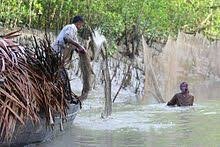
The Sundarbans is a vast forest in the coastal region of the Bay of Bengal, considered one of the natural wonders of the world, it was recognised in 1997 as a UNESCO World Heritage Site. Located in the delta region of Padma, Meghna and Brahmaputra river basins, this unique forest area extends across South 24 Parganas and, North 24 Parganas districts of West Bengal State, India and Khulna, Satkhira, Bagerhat districts of Bangladesh. The Sundarbans is the world's largest coastal mangrove forest, with an area of approximately 10,000 sq km; of which approximately 6,000 sq km is situated in Bangladesh and approximately 4,000 sq km in India. The Bangladeshi and Indian parts of the Sundarbans, while in fact adjacent parts of the uninterrupted landmark, have been listed separately in the UNESCO World Heritage List: as "Sundarbans" and "Sundarban National Park" respectively. The Sundarbans are a network of marine streams, mud shores and mangrove forests. The region is known to contain numerous species of animals, birds and reptiles, including Royal Bengal Tiger, Chital Deer, Crocodile and Snakes . On 21 May 1992, the Sundarbans was recognized as a Ramsar Site of ecological importance.
.jpg)
Natural hazards[edit]
According to a report created by UNESCO, the landfall of Cyclone Sidr damaged around 40% of Sundarbans in 2007.[38]
.jpg)
Really nice place to visit..
Hi! I am a robot. I just upvoted you! I found similar content that readers might be interested in:
https://en.wikipedia.org/wiki/Sundarbans
Very nice photography.
nice place to visit.